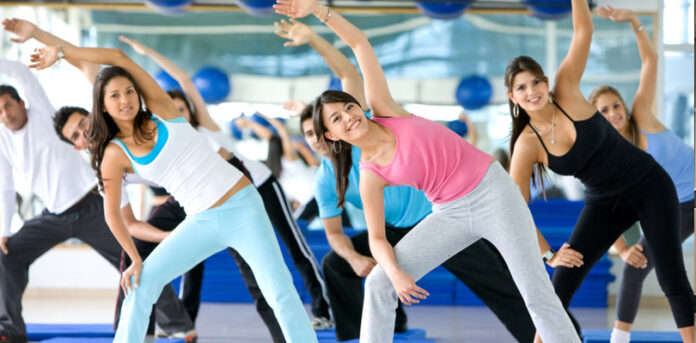Are you looking for a way to improve your cardiovascular health, boost your endurance, and burn some calories in the process? Then aerobic exercise may be just right for you! As well as being known as cardio, aerobic exercise involves rhythmic movements and continuous oxygen consumption, which increases both heart rate and breathing. From low-impact activities like walking and cycling to high-intensity activities like running and jumping rope, we’ll explore the different types, benefits, and how to get started with aerobic exercise.
But it’s not just about the different types of aerobic exercise – we’ll also explore the numerous benefits of this type of workout. Cardio can reduce the risk of chronic diseases such as diabetes and heart disease, but can also boost your mood and boost your brain. It doesn’t matter if you are a beginner or an experienced gym-goer, this post will provide you with all the information you need to incorporate aerobic exercise into your daily routine.
Best Aerobic Exercise

Aerobic exercise is a great way to improve cardiovascular health, increase endurance, and burn calories. It involves continuous, rhythmic movements that help to increase heart rate and breathing. There are many different types of aerobic exercises, and in this article, we’ll explore 7 of the top ones.
Running
Running is a high-impact aerobic exercise that can be done indoors or outdoors. It’s a great way to improve cardiovascular health and endurance. Running can also help to strengthen your bones, improve your mood, and reduce the risk of chronic diseases.
Walking
Walking is a low-impact aerobic exercise that can be done indoors or outdoors. It’s a great way to improve cardiovascular health and burn calories. Walking can also help to reduce the risk of chronic diseases, improve your mood, and increase your energy levels.
Cycling
Cycling is a low-impact aerobic exercise that can be done indoors or outdoors. It’s a great way to improve cardiovascular health and endurance. Cycling can also help to strengthen your legs, improve your mood, and reduce the risk of chronic diseases.
Swimming
Swimming is a low-impact aerobic exercise that can be done indoors or outdoors. It’s a great way to improve cardiovascular health and endurance. Swimming can also help to strengthen your muscles, improve your mood, and reduce the risk of chronic diseases.
Jumping Rope
Jumping rope is a high-impact aerobic exercise that can be done indoors or outdoors. It’s a great way to improve cardiovascular health and burn calories. Jumping rope can also help to improve your coordination, balance, and agility.
Dancing
Dancing is a low-impact aerobic exercises that can be done indoors or outdoors. It’s a great way to improve your cardiovascular health and have fun at the same time. Dancing can also help to improve your balance, coordination, and flexibility.
HIIT (High-Intensity Interval Training)
HIIT is a type of aerobic exercise that involves short bursts of high-intensity activity followed by periods of rest or low-intensity activity. It’s a great way to improve cardiovascular health, increase endurance, and burn calories. HIIT can also help to improve your metabolism and reduce the risk of chronic diseases.
In conclusion, these 7 top aerobic exercises offer a range of options for individuals with different fitness levels and preferences. It’s important to choose an aerobic exercise that you enjoy and can incorporate into your routine to reap the numerous benefits it offers for your health and well-being.
Benefits Of Aerobic Exercise
Aerobic exercise is a great way to improve your overall health and well-being. It involves continuous, rhythmic movements that help to increase heart rate and breathing, resulting in a range of benefits for both physical and mental health. Here are 5 benefits of aerobic exercises in detail:
Improved Cardiovascular Health
Aerobic exercise is excellent for improving cardiovascular health, which refers to the health of the heart and blood vessels. Regular aerobic exercise helps to strengthen the heart muscle, increase blood flow, and reduce the risk of cardiovascular diseases such as heart attacks, strokes, and high blood pressure.
Increased Endurance
Aerobic exercise helps to increase endurance, which is the ability to perform physical activity for longer periods without feeling fatigued. Regular aerobics can improve lung capacity and increase the body’s ability to use oxygen efficiently, leading to increased endurance.
Weight Loss And Management
Aerobic exercise is a great way to burn calories and lose weight. By performing aerobic exercises regularly, the body burns stored fat as fuel, leading to weight loss. Aerobic exercises also help to maintain a healthy weight and prevent obesity-related conditions such as diabetes, high blood pressure, and heart disease.
Improved Mental Health
Aerobic exercise is also beneficial for mental health. It helps to reduce stress, anxiety, and depression, and improve mood. Aerobic exercise releases endorphins, which are chemicals that promote feelings of happiness and well-being.
Reduced Risk Of Chronic Diseases
Regular aerobic exercise can reduce the risk of chronic diseases such as diabetes, heart disease, and certain types of cancer. Aerobic exercises help to improve insulin sensitivity, reduce inflammation, and boost the immune system, which can all contribute to reducing the risk of chronic diseases.
In conclusion, incorporating these exercises into your routine can offer a range of benefits for both physical and mental health. By improving cardiovascular health, increasing endurance, aiding weight loss, improving mental health, and reducing the risk of chronic diseases, aerobic exercises can help you live a healthier, happier life.
Tips And Techniques Of Aerobic Exercise
Aerobic exercises are an excellent way to maintain a healthy and active lifestyle. However, it’s essential to perform these exercises correctly and safely to reap the maximum benefits. Here are 5 tips and techniques to follow when doing aerobic exercises:
Warm-Up And Cool-Down
Before starting any aerobic exercise, it’s crucial to warm up the body. A warm-up prepares the muscles for exercise and reduces the risk of injury. It’s also essential to cool down after exercise to help the body recover. A cool-down involves stretching and slowing down the pace of the exercise gradually.
Start Slowly And Progress Gradually
If you’re new to aerobic exercise, it’s essential to start slowly and gradually increase the intensity and duration of the workout over time. This approach helps the body adapt to the exercise and reduces the risk of injury.
Use Proper Technique
Using proper technique when performing aerobic exercises is crucial to avoid injury and getting the most out of the workout. For example, when running, make sure to land on the balls of your feet, not your heels. When cycling, adjust the seat height to ensure that your legs are fully extended when pedaling.
Mix It Up
Varying the types of aerobic exercises, you perform can prevent boredom and challenge different muscles. For example, you can alternate between running, cycling, and swimming to work for different muscle groups and improve overall fitness.
Stay Hydrated
It’s essential to stay hydrated during aerobic exercises to maintain energy levels and prevent dehydration. Make sure to drink water before, during, and after exercise, especially if you’re exercising in hot or humid conditions.
In conclusion, incorporating these tips and techniques into your aerobic exercise routine can help you stay safe, get the most out of your workout, and enjoy the numerous benefits aerobic exercises offers. Remember to warm up and cool down, start slowly, use proper technique, mix up your exercises, and stay hydrated to stay healthy and active.
FAQs
How often should I do aerobic exercises?
The American Heart Association recommends that adults engage in at least 150 minutes of moderate-intensity aerobic exercise or 75 minutes of vigorous-intensity aerobic exercise per week. This can be spread over the week and divided into smaller sessions. It’s also important to incorporate strength training exercises at least twice a week for overall health and fitness.
Can aerobic exercise help me lose weight?
Yes, aerobic exercise can help you lose weight by burning calories and reducing body fat. However, it’s important to maintain a healthy and balanced diet while engaging in aerobic exercises for weight loss. Combining aerobic exercise with strength training can also help build lean muscle mass, which can further aid weight loss.
Are there any risks associated with aerobic exercise?
Aerobic exercise is generally safe for most people, but it’s important to talk to a healthcare provider before starting any exercise program, especially if you have any underlying health conditions or are pregnant. There are some risks associated with these exercises, such as the risk of injury or overuse, which can be reduced by using proper technique, wearing the appropriate gear, and gradually increasing the intensity of the exercises. It’s also essential to listen to your body and stop if you experience any pain or discomfort during exercise.

